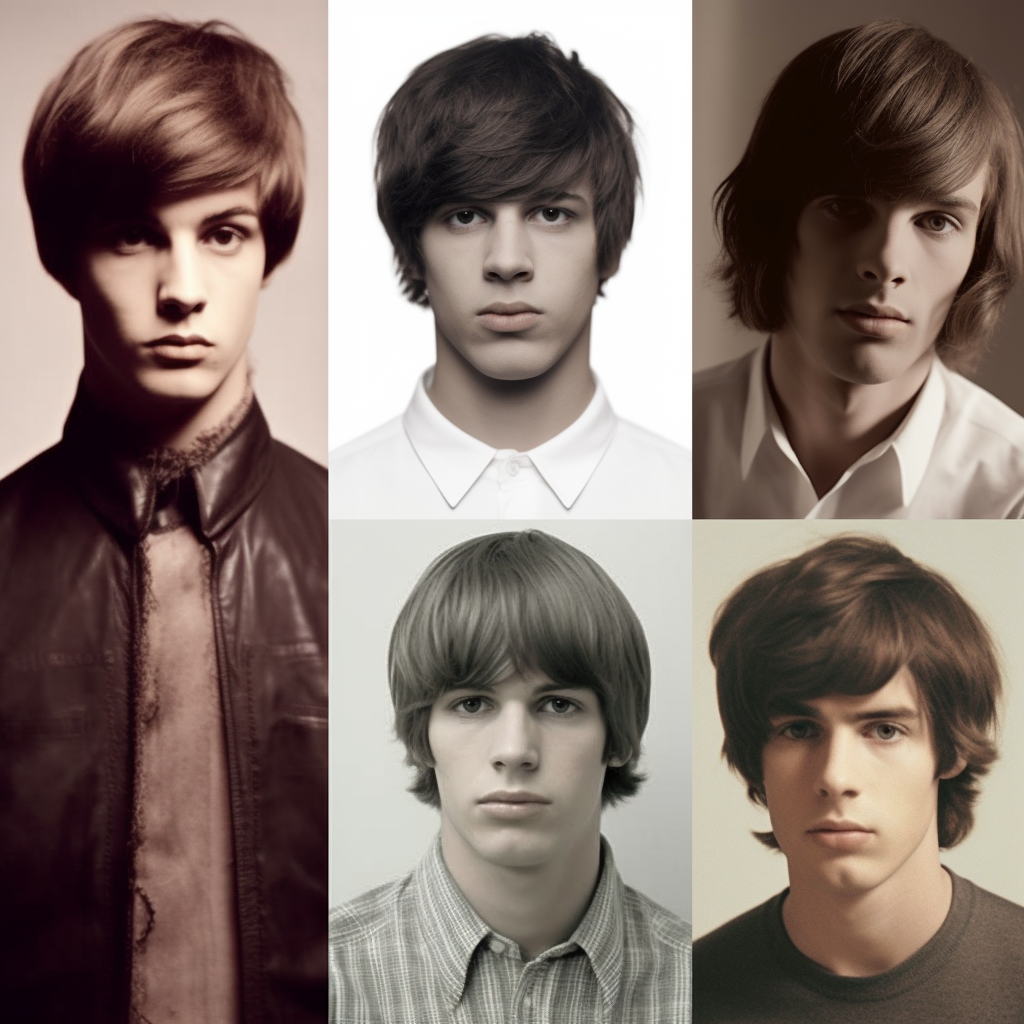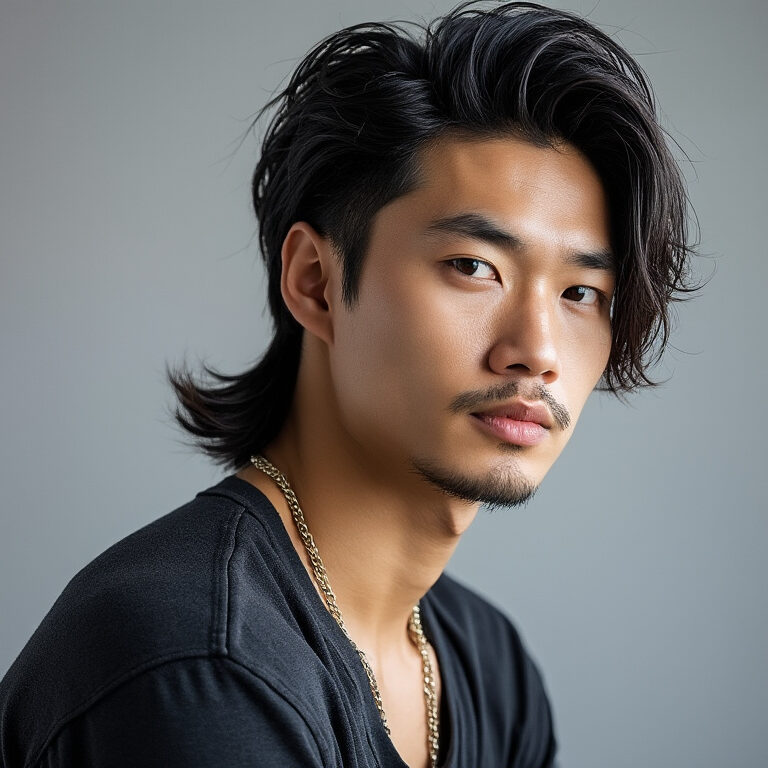1800s Men’s Hairstyles: Timeless Styles That Defined a Century
The 19th century was a time of transformation, characterized by industrialization, societal shifts, and cultural movements like Romanticism and Neoclassicism. These shifts were reflected in men’s hairstyles, which transitioned from the elaborate and powdered styles of the 18th century to sleeker, more practical looks. Each hairstyle from the 1800s told a story of identity, social standing, and personal values.

Far from being mere fashion statements, these hairstyles symbolized identity, class, and cultural values, evolving alongside the tumultuous era they represented. From the revolutionary simplicity of the Titus cut to the polished sophistication of Victorian grooming, the era’s hairstyles continue to influence fashion to this day.
The Cultural Context of 19th-Century Grooming
Industrialization and Changing Lifestyles
The Industrial Revolution brought unprecedented changes to daily life, influencing fashion, grooming, and societal norms. Urbanization and factory work reshaped how men viewed and managed their appearance.

- Practical Styles for Workers: Laborers gravitated toward short, low-maintenance haircuts that suited their physically demanding jobs. Cropped cuts became synonymous with practicality.
- Emerging Middle-Class Refinement: As the middle class expanded, men began emulating the polished styles of the aristocracy, blending simplicity with sophistication.
These societal shifts underscored the role of grooming as both a necessity and a marker of aspiration.
The Titus Cut: A Revolutionary Statement
The Titus cut stands as one of the most iconic hairstyles of the early 19th century. Drawing inspiration from ancient Rome men’s hairstyles, this short, structured cut symbolized a rejection of the excesses of the 18th century.

- Origins: Popularized during the French Revolution, the Titus cut was named after Emperor Titus and reflected neoclassical ideals. It was a deliberate departure from the extravagant wigs that had dominated the aristocracy.
- Cultural Symbolism: The cut embodied revolutionary values of equality, simplicity, and discipline. It was especially favored by artists and intellectuals who admired Roman ideals of masculinity.
For visual reference, consider the artwork of Jacques-Louis David, whose neoclassical portraits often featured men with this clean, cropped style.
Romanticism’s Influence on Hairstyles
The Romantic movement of the early 19th century celebrated individuality, creativity, and emotion. These ideals extended to men’s grooming, inspiring styles that embraced natural textures and longer lengths.

- Signature Look: Longer, wavy hairstyles became popular among poets, painters, and philosophers, symbolizing introspection and rebellion against societal constraints.
- Figures of Note: Lord Byron, a leading Romantic poet, epitomized this aesthetic with his flowing, shoulder-length hair. His portraits capture the essence of the Romantic spirit.
Romantic hairstyles often combined a slightly unkempt appearance with an underlying sophistication, making them both personal and stylish.
Regency Era Grooming: The Rise of the Dandy
The Regency period (1811–1820) saw the rise of the dandy, a man who elevated personal grooming and fashion to an art form. Beau Brummell, the quintessential dandy, revolutionized men’s grooming with his minimalist yet meticulous approach.
- Hairstyles of the Era: Regency men favored short, natural hair, often paired with prominent sideburns. This marked a shift from the ostentatious wigs of previous decades.
- Brummell’s Legacy: Known for his fastidious grooming, Brummell popularized a neat, understated look that emphasized cleanliness and precision.
The Regency period also embraced a blend of Romantic and neoclassical influences, with hairstyles reflecting both practicality and cultural ideals.
Victorian Hairstyles: Polished Perfection
By the mid-19th century, the Victorian era ushered in an age of meticulous grooming and polished appearances. Men’s hairstyles and facial hair became symbols of respectability, discipline, and masculinity.

Popular Hairstyles
Victorian men favored sleek, controlled hairstyles that conveyed a sense of order and refinement:
- Slicked-Back Look: Using pomades and oils, men combed their hair back for a clean, professional appearance.
- Side-Parted Styles: Precise parting added a touch of sophistication, often paired with well-maintained facial hair.
19th-Century Men’s Grooming: Facial Hair as a Statement
Facial hair reached its peak popularity during the Victorian era, with styles like mutton chops, handlebar mustaches, and full beards dominating men’s grooming.
The Origin and Popularity of Mutton Chops
Mutton chops, characterized by thick sideburns that extend down the cheeks while leaving the chin clean-shaven, became a hallmark of men’s grooming during the 19th century. While variations of facial hair styles predate this era, mutton chops as a distinct and widely popular style rose to prominence in the early 1800s and were particularly emblematic of the Victorian period.

Historical Roots of Mutton Chops
The term “mutton chops” originated as a colloquial reference to the style’s resemblance to the shape of a mutton cutlet—a popular food item of the time. However, the concept of thick sideburns can be traced back even earlier, appearing in military portraits and aristocratic depictions from the late 18th century. By the early 19th century, the look evolved into a definitive trend, gaining popularity across Europe and North America.
The rise of mutton chops coincided with a broader cultural emphasis on masculinity and individualism. The Industrial Revolution and the Romantic movement both contributed to this aesthetic shift, with facial hair becoming a way for men to distinguish themselves and project strength, virility, and sophistication.

Cultural and Iconic Associations
Mutton chops were often associated with rugged masculinity, a trait admired in the Victorian era. This style was particularly popular among prominent figures, including politicians, authors, and military leaders. Charles Dickens is perhaps one of the most famous historical figures to sport mutton chops, and his carefully groomed facial hair became a defining part of his public persona. Dickens’ mutton chops reflected his status as an intellectual and a cultural figurehead of Victorian England, and they remain iconic in portraits of the celebrated author.

- Mutton Chops: Thick sideburns extending to the cheeks became a symbol of rugged sophistication. Charles Dickens is a prime example of this style.
- Handlebar Mustaches: Known for their curled ends, handlebar mustaches projected confidence and required careful maintenance with wax.
- Full Beards: Beards signified maturity and authority, particularly among older men and leaders.
Advancements in Grooming
The Industrial Revolution also brought innovations in grooming tools and products:
- Better Tools: Improved combs, brushes, and clippers allowed men to achieve precise styles.
- Pomades and Oils: Commercially available grooming products ensured lasting hold and shine.
Long Hair: Creativity and Prestige
While shorter styles dominated much of the 19th century, long hair retained its place among certain groups, particularly artists, intellectuals, and members of high society.

Cultural and Artistic Significance
Long hair symbolized cultural refinement and creative freedom. It aligned with Romantic ideals, suggesting introspection and a connection to historical traditions.
Grooming Practices
Maintaining long hair required dedication:
- Regular washing with natural soaps or herbal rinses.
- Daily brushing to prevent tangles and maintain a groomed appearance.
- Application of oils for shine and health.

Artists like the Pre-Raphaelites often depicted men with flowing locks, emphasizing the association between long hair and artistic expression.
The Decline of Powdered Wigs
Powdered wigs, a staple of 18th-century aristocratic fashion, fell out of favor during the 1800s. By the Regency period, natural hairstyles had become the norm, reflecting a cultural shift toward simplicity and practicality. The decline of wigs marked the end of an era dominated by elaborate grooming.
The Pompadour: A Bold Late-Century Style

Although the pompadour is often associated with later periods, it began gaining popularity among men in the late 1800s. Featuring hair swept upward and back, this style projected confidence and flair. Its resurgence in the 20th century further cemented its place in men’s fashion history.
Icons of 19th-Century Hairstyles
Prominent figures of the 1800s helped popularize and define the era’s hairstyles. Their portraits and photographs offer a glimpse into the grooming trends of the time:
- Charles Dickens: With his mutton chops and neatly combed hair, Dickens embodied Victorian grooming.
- Lord Byron: His wavy, shoulder-length hair symbolized the Romantic ideal.
- Beau Brummell: The dandy’s minimalist style redefined Regency fashion.
- Buffalo Bill: His handlebar mustache reflected rugged individuality.
- Prince Albert: Known for his polished, side-parted hair, Prince Albert set a standard for royal elegance.

Studying these figures provides valuable insights into how hairstyles reflected personal and cultural identities.
The Enduring Legacy of 1800s Men’s Hairstyles
Each hairstyle from this period carried a distinct narrative. The Romantic long locks of poets like Lord Byron reflected rebellion, creativity, and individuality, while the neatly slicked-back styles of Victorian gentlemen represented order, discipline, and sophistication. Even facial hair trends, such as the bold mutton chops and handlebar mustaches, expressed evolving ideals of masculinity, linking grooming with power, authority, and personal flair.

A Lasting Impact on Modern Grooming
The legacy of 1800s men’s hairstyles is evident in today’s grooming practices. Many of the techniques and tools that emerged during this era laid the groundwork for contemporary grooming routines. The use of pomades, oils, and precision grooming tools has carried forward, maintaining the 19th-century emphasis on achieving a polished and tailored look. For instance, the popularity of beards and mustaches in modern times can trace its lineage back to Victorian facial hair trends, where grooming one’s beard was an art form.

Moreover, the influence of 19th-century style icons continues to resonate. Figures like Beau Brummell, Charles Dickens, and Prince Albert shaped enduring grooming standards, proving that the concepts of neatness, minimalism, and sophistication are timeless. Their images, immortalized in paintings, illustrations, and early photographs, continue to inspire fashion and grooming enthusiasts seeking a connection to history.
The Cultural Significance of Hairstyles
In the 1800s, hairstyles were deeply tied to cultural identity and societal status. They often reflected a man’s profession, values, and aspirations. For example, the Titus cut, with its classical inspiration, spoke to a desire for simplicity and virtue during a time of political upheaval. Similarly, the slicked-back styles of the Victorian era symbolized the industrial age’s focus on control, progress, and precision.

Today, men’s hairstyles continue to serve as expressions of personality and cultural identity, much like they did in the 19th century. From modern adaptations of side-parted Victorian hair to the resurgence of bold mustaches reminiscent of Buffalo Bill, these styles demonstrate how grooming transcends time, bridging the past with the present.
A Story of Transformation and Timelessness
At its core, the story of 1800s men’s hairstyles is one of transformation—an evolution from the elaborate wigs of the 18th century to the natural, tailored looks that defined the modern man. It is a journey that highlights humanity’s capacity to adapt, innovate, and create beauty in response to the world’s changes. These hairstyles also remind us that grooming is not merely about aesthetics; it is about telling a story, claiming an identity, and asserting one’s place in society.

Through the lens of history, the hairstyles of the 19th century remain more than relics of the past. They continue to inspire, challenge, and shape how we think about men’s fashion and grooming today. Whether in art, literature, or pop culture, the influence of 1800s men’s hairstyles endures, a testament to the timeless appeal of tradition blended with individuality.
Their legacy is a vivid reminder of an era when haircuts were not just about appearance but about expressing who you were, what you believed, and where you belonged in a rapidly changing world. In every meticulously groomed sideburn or slicked-back coiffure, the echoes of the 19th century resonate, proving that style and history are forever intertwined.





